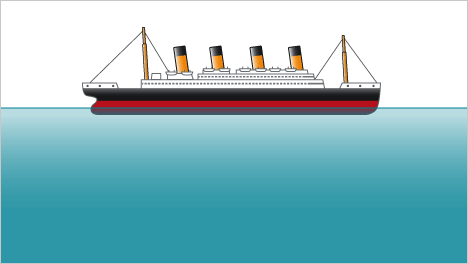
14 April 1912 shortly before midnight: the lookout on duty made out a giant iceberg lying directly in the ship's path. An evasion manoeuvre was immediately ordered, but it was too late. The luxury steamer collided at full steam with the ice mass weighing roughly 300,000 tonnes. Once the damage was ascertained, one thing was quickly apparent. The Titanic would sink. Emergency calls were sent shortly after midnight and the evacuation of the ship was ordered.

Get paid for extra space in your website
But it was some time before the passengers realised the danger they were in. Some people even refused to enter the lifeboats, perhaps lulled into the false belief that the ship could not possibly sink. Around two hours later, the bow had almost completely submerged. The stern was forced sharply upwards out of the water. The ship's hull broke in two. The Titanic sank.
In the opinion of Edwin Mast, a technical-nautical expert at Munich Re and a seaman with a ship master's certificate, things could have turned out differently: "The scale of the disaster would probably have been diminished if the watch officer had not tried to avoid the iceberg and the ship had instead struck it head on."
The ship's hull was divided lengthwise into 16 compartments, each separated by vertical, watertight steel walls. Even if four of these filled with water (which was considered highly unlikely), the ship would still not sink.
But the collision tore open six of the compartments below the waterline. A single design detail would have fatal consequences: the bulkheads had not been carried up to the top deck. In some cases, the water poured into neighbouring compartments that were still undamaged. The fully submerged bow pushed the ship downwards.
Eventually, the bending moments became so great that the ship's hull broke in two and the Titanic sank.
The tragic event was a wake-up call for the leading shipping nations around the world that would lead to the establishment of stricter, uniform international safety standards. The first SOLAS (International Convention for the Safety of Life at Sea) treaty came into force in 1914, and this was revised and updated several times in the years that followed. From 1958, the International Maritime Organisation (IMO), which was established under the aegis of the UN, assumed responsibility for this convention, and since then it has worked to develop safety standards further.
Under SOLAS, ships today must have room in a lifeboat for all passengers and crew, and only closed lifeboats are permitted. In addition, there must be life rafts for one quarter of the passengers on board. Special suits protect crew members from freezing during the evacuation procedure. Many passengers on the Titanic were injured because they jumped into the lifeboats from a height. Today, this risk has been greatly reduced by the use of evacuation chutes.
Unclear instructions and lack of training on the Titanic resulted in some lifeboats being launched with just a few people in them. Nowadays, passenger ship crews must undergo emergency training and take part in a weekly fire and evacuation drill. Since 1978, these regulations have been set out in the International Convention on Standards of Training, Certification and Watchkeeping for Seafarers (STCW).
Needless to say, technical developments have also helped greatly to make shipping much safer today: the Titanic still broadcast on short wave using Morse code, which had extremely limited transmission quality and range. Today there are digital satellite connections virtually worldwide that can be used for communication purposes and to locate ships.
from http://www.munichre.com/en/reinsurance/topics-online/2012/02/titanic/default.aspx
Nice informations.
ReplyDeleteNeo conveuors are leader in manufacturing of industrial conveyor systems.Please visit our blog
1.choosing-the-right-type-of-belt-conveyor-system
2. types-screw-conveyors-bulk-materials-handling
3. economical-and-safely-materials-handling-by-incline-conveyors
3. how-to-select-conveyors